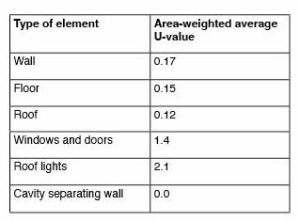The Scottish Building Standards’ new Section 6 requirements support Scotland’s goal of achieving net zero emissions by 2045, with a stretching 75% reduction target by 2030. Effective from 1st February 2023, these changes require an aggregated 20% improvement in CO2 emissions over the 2015 standards for non-domestic buildings. The changes pave the way for nearly zero energy buildings – NZEBs – which are highly energy efficient, with most of their energy demand met by renewable sources.
Five significant impacts of the new Section 6
The key impacts of Section 6 fall into the following areas:
- Higher standards for energy efficiency: buildings must be more energy-efficient than ever before. New buildings must incorporate energy-saving measures such as high-performance insulation, airtightness measures, and efficient heating and ventilation systems.
- Greater emphasis on renewable energy: there is a greater emphasis on using renewable energy sources, such as solar and wind power. Buildings will need to use renewable energy technologies wherever possible.
- Increased costs: building new homes and commercial buildings will cost more, as more expensive energy-saving technologies and renewable energy systems will add to the overall construction cost.
- Improved comfort and indoor air quality: the greater emphasis on indoor air quality and comfort involves specifying better ventilation systems in new buildings, which will help to reduce the risk of indoor air pollution and create a more comfortable indoor environment.
- Reduced carbon emissions: buildings are a major source of carbon emissions – reducing these emissions through Section 6 is essential if Scotland is to meet its climate change targets.
How does Scotland’s approach differ from England and Wales?
The crux of the matter is Scotland’s introduction of delivered energy as a target. In England and Wales, the Primary Energy Target introduced within Part L of Building Regulations considers the total energy needed to create a delivered unit of energy. The Scottish approach also involves improved area-weighted average U-values for building envelope elements, tighter minimum standards for building services, and fewer exceptions for airtightness testing.
An updated version of the Simplified Building Energy Model (SBEM) provides a standard methodology of compliance calculation for Scottish commercial buildings. There are three variations of the notional building used to develop the Target Emission Rate (TER) based on different heating options, including:
- Electric heat pumps
- Heat networks
- Other types of heating solutions.
It should be noted that the Target Delivered Energy Rate (TDER) will eventually replace the Target Emission Rate (TER). In the interim, both must be met in buildings using fossil fuels (gas/oil) for heating. Only the new TDER applies to buildings using heat pumps or electric panel heaters.
How does Section 6 impact insulation?
Standard 6.2 states: ‘Every building must be designed and constructed in such a way that an insulation envelope is provided which reduces heat loss.’ More stringent U-values for building elements mean, in simple terms, that more insulation will be required to improve thermal performance. For example, as set out in the updated Technical Handbooks:
- Domestic external walls’ U-value has decreased from 0.22 to 0.17
- Domestic roofs must achieve a U-value of 0.12, reduced from 0.15
- Non-domestic external walls’ U-value has dropped from 0.27 to 0.21
- Non-domestic roofing must achieve a U-value of 0.16, reduced from 0.2
The ‘broad-brush’ maximum U-values for building elements of the insulation envelope in new buildings are set out below (refer to p 440 of the Domestic Technical Handbook, and p 470 of the Non-Domestic Technical Handbook, for comprehensive details of variations and exceptions):
DOMESTIC MAXIMUM U-VALUES

NON-DOMESTIC MAXIMUM U-VALUES

Where a building is being converted or renovated, the level of insulation should be improved as far as possible. These lower U-values make higher levels of insulation to all parts of a building’s envelope a prerequisite to achieve compliance.
The stringent nature of the new U-value targets is illustrated in the requirements for the notional building set out in the following table:

The new Section 6 represents a significant step towards the rapid decarbonisation of Scotland’s built environment, setting the stage for more advances in energy efficiency as we move towards net zero. However, more changes are likely to come, and the takeout must be that specifying to the highest level not only reduces each structure’s carbon footprint but preempts the risk of a costly retrofit.

